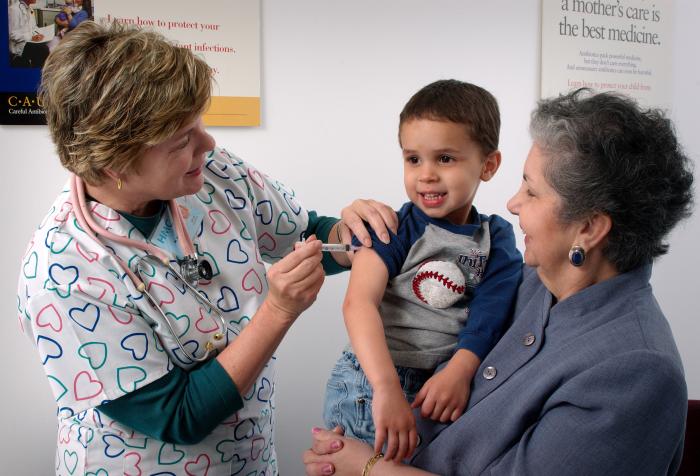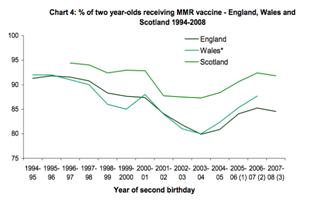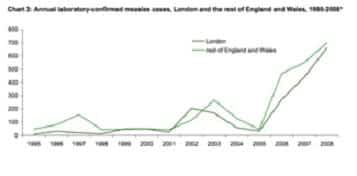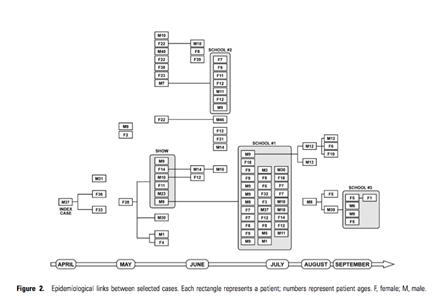The number of cases of vaccine-preventable diseases among children is on the rise. The decrease in the vaccination rate is the reason why when an epidemic breaks out it is difficult to stop it and it is a shame

Following a problematic study, the results of which have since been refuted in 12 large, controlled studies, and even Removed from the original magazine that published it, concerned parents began to link the triple vaccine to autism. The connection found by the initial study can be explained by the fact that autism is a disease that shows its first signs in early childhood, which is also the period when many vaccines are given. The statistics require that some children will be diagnosed with autism close to receiving a vaccine (and also personal interests that have since been published by the author of the original article). What does cause autism? We don't really know yet, but the evidence accumulating in studies points to a problem in the way the nerve cells arrange themselves in the brain even in the early stages of pregnancy. But the parental panic took its toll and since that article a movement has arisen opposing vaccines in general which has led to a decrease in the number of children receiving vaccination. The number of cases of vaccine-preventable diseases among children is on the rise.
Those who write about vaccines and autism (including me) receive quite a few hostile responses - why? Parents of autistic children may be sensitive and angry and find it difficult to accept different opinions from their own, these feelings are understandable but should not be an equal consideration to the results of scientific studies. The anti-vaccination movement claims that there is no balance in media reports, but why should there be? Should creationism be represented every time evolution is talked about? Science is all on the same side. There is no scientific debate as the movement tries to present in the media. The movement focuses on anecdotes, dramatic stories that sell well in the media. A good example of this is the story of the beautiful cheerleader Desiree Gunnings. About ten days after receiving a flu shot, she began to show signs of a nervous illness. The media rushed to publish the news, but you will not find the report that in the end it was discovered that it was a psychosomatic phenomenon (meaning it was all in her head and she was not really sick). So Google perpetuates the biased reporting. We love stories, that's how we evolved, it's a natural love. Critical thinking requires study and effort, but it is the one that leads to the proper conclusions.
Why does it bother me so much that people don't get vaccinated? After all, it can be thought that this is their problem, if there is an outbreak, they will get sick and not me. The reality is more complex than that. The thing is, no vaccine is perfect. If we take for example the measles vaccine (which is part of the triple vaccine), it is only 90-97% effective. That is, out of 100 people who receive the vaccine, 3-10 will still not develop resistance to the disease even if the entire population is vaccinated.
Therefore, we all rely on herd immunity. Herd immunity is a fascinating effect and one of the pillars of the public vaccination effort. The idea is that if enough people in the population are vaccinated against a certain disease, then those who are susceptible to the disease will rarely encounter it, and the disease will have a hard time spreading. This leads to lowering the risk of infection for the entire population regardless of personal immunity. Who are sensitive? Those 3-10% for whom the vaccine did not develop properly, but also recipients of drugs that suppress the immune system due to transplants, recipients of chemotherapy against cancer, recipients of steroids against asthma, those who are too young (under one year old), those who are allergic to the components of the vaccine, and more. We all know at least one of these. I did a count, from what I know in my immediate environment, people I see at least once a week, there are four watches on these settings. There must be more that I just don't know about. These are people who trust my vaccine.
Thanks to Dr. Andrew Wakefield (Wakefield), author of that famous article, fear of the MMR vaccine as a cause of autism led to a decrease in the number of measles vaccinations, especially in England. Vaccinations in England have declined to such an extent that at one point 20% of children were exposed to the possibility of contracting measles, mumps and rubella. A significant decrease in receiving vaccinations was evident in the years 2000-2004, a figure that can be attributed to a decrease in public confidence in the triple vaccine.

As a result measles flourished:

"(in free translation) It seems that the dispute affected parental decision-making. The rates of acceptance of the triple vaccine in England fell from 87.4% in 2001 to 79.9% in 2004, the lowest percentage since the vaccinations began in 1991. The decline is even more significant in light of the fact that receiving separate vaccines was only available through private medicine at a cost of about £200... Wakefield's experiment was widely disproved and rates of receiving the triple vaccine recovered. In 2007 they stood at 84.6%. Meanwhile, the measles alerts in 2006-2007 were the highest in a decade."
A drop in vaccination rates exists mainly among established populations grouped in alternative schools (the problem with religious groups has existed for many years). Herd immunity and the models that try to predict the vaccination rates necessary to protect a population are based on the fact that the unvaccinated people are randomly scattered in the population, and not grouped in alternative schools. In the Canadian province of Quebec, such an outbreak led to 94 measles cases despite a high level of immunity in the general population (95%).
The following graph shows how the alternative schools helped increase the epidemic:

In the summary of the article it is said:
"An important assumption of the mathematical models is that the unvaccinated people are randomly distributed in the population. In reality, the unvaccinated are not randomly distributed. Religious groups that oppose vaccines are often very united populations. The outburst in the article concerned two unrelated alternative schools attended by children whose parents opposed vaccinations on a philosophical basis, showed that these people are also grouping together.... The progression of the disease through several generations of patients raises the possibility that small changes in the vaccination rate in the population, or in the level of grouping of unvaccinated people, lead to continued infection despite a 95% immunity rate in the population."
The staggering success of vaccines has led to the belief that because of the protection of herd immunity, individuals now have the option of avoiding the cost and risk of vaccination with the thought that they have the same reduction in risk as if they had been vaccinated.
Even if we put aside the fact that there are people who have no choice but to rely on herd immunity as their only line of defense against disease. Even if we forget that there is a threshold below which herd immunity collapses, and finally, we will ignore the ethical aspect of profiting from the sacrifice of the other while eroding the effectiveness of the herd immunity that is being exploited. Does the method of hiding within herd immunity provide the same protection as getting vaccinated, without taking the small risk of vaccinations?
Unequivocally, no.
Many reports of outbreaks from around the world consistently describe a disproportionate number of infections during outbreaks of vaccine-preventable diseases occurring in the unvaccinated. For example, bIndiana In 2005 an outbreak of measles infected 34 people. The outbreak was caused by an unvaccinated 17-year-old girl who contracted the disease in Romania. In this outbreak, 94% of those infected were unvaccinated. The scenario was repeated during a measles outbreak inCalifornia In 2008 when 12 children were infected. The source of the infection was an unvaccinated boy who traveled in Europe, and infected his brother, five classmates and four children in his pediatrician's office. None of the children were vaccinated, although three of the children who were in the doctor's office were too young to receive the vaccine (In Israel, the vaccine is given above the age of one year). Not even one vaccinated child was infected.
These reports demonstrate how quickly the disease can spread and how easily the unvaccinated are affected by it. They also demonstrate the effectiveness of herd immunity in preventing the spread of the disease, and quite unequivocally suggest that even with normal herd immunity, the vaccinated and the unvaccinated are not at the same levels of risk.
How much greater is the risk of the unvaccinated? 10%?, 50%? double? These numbers are important for parents who have to make the decision as well as doctors who weigh the effectiveness of the vaccine against the risk it brings. A group of researchers from Colorado tried to help put a number on the increased risk. During the last year they published two studies that quantified the magnitude of the risk to children due to vaccine refusal.
הThe first article found that refusing to vaccinate against whooping cough put children at 23 times greater risk of contracting the disease. This is a 23 times greater risk of contracting the disease over the years 2000-2004, in the USA, required hospitalization in 62.8% of cases under the age of one year (in Israel the vaccine is given at the age of two months), 55.8% experienced apnea, 12.7% pneumonia and death in 0.8% of the cases. theThe second study Theirs focused on chicken pox due to vaccine refusal. Here they found an 8.6 times greater risk of contracting the disease, which until the release of the vaccine in1995 Caused in the USA three million infections, 10,000 hospitalizations, 4,000 cases of pneumonia, 600 cases of meningitis and 100 deaths every year.
These findings reinforce the fact that even in a population with normal herd immunity, the choice to remain unvaccinated puts the children at a much greater risk than their vaccinated peers. The illusion that herd immunity provides as much protection as the vaccine itself must be abandoned.
clearly and honestly.
The choice to refuse vaccination, to "hide in the herd", is an active choice to accept the much increased risk of infection, its complications, the associated medical costs and loss of wages, the responsibility for spreading the disease to others should infection occur, and the choice to undermine the immunity of the herd on which we all rely. On the question of whether to get vaccinated or not, there is no option to "sit on the fence".
Parents want to be fully informed about the medical decisions they make for their children, and their full right is reserved with them. In this case we do the public a disservice when we let the public discourse be dominated by the risks of vaccines versus other important issues, such as the risks of not being vaccinated. These studies are necessary and welcome and provide important insights for people who want to make informed decisions.
History tends to repeat itself, but do we really want to reach a situation where all those terrible childhood diseases will once again run rampant in the population? Do you really have to wait for children to start dying?
Sources:
Science based medicine – one, Two
More information about vaccines can be found atThe special page for parents established by the Children's Hospital of Philadelphia (English).

10 תגובות
I just got to the article now. Although this is not a scientific article - if you dismiss the pseudo-science of others - you should be careful with pseudo-science - the statistical relationship between the two graphs of the percentage of people who get vaccinated is less than weak - it simply does not exist. An increase in measles cases (with a subsequent decrease) exists even before the decrease in the vaccination rate began. The latest increase continues despite a rebound in the vaccination rate. The increase in the number of cases is sharp and occurs many years after the beginning of the decline in the vaccination rate. It is too dramatic to be explained by the gradual decline, etc.
Rabies is a very dangerous and highly contagious disease.
Why not vaccinate the entire population against rabies?
The question was and remains: risk versus chance.
Here is another example from a completely different field where the risk is weighed against the chance:
In one terrorist attack, 50 people may be injured.
Is it worth handing out weapons to the population to defend against a terrorist attack?
Dr. Palavski explains:
"The whole concept of herd vaccination is very interesting, because we are taught that herd vaccination happens because a certain percentage of the population has actively received the disease. Because of this, by a certain percentage of the population getting the disease, these people provide protection to the rest of the population, which has not yet received the disease.
And so, the herd that gets the disease sheds it and protects those who didn't get it.
In vaccine science, we postulate or conclude that if we vaccinate a certain percentage of people, we thereby provide protection to those who have not been vaccinated. This has not been proven to be true, because the real herd vaccination phenomenon is based on an active disease, and we know that, despite what we are taught, a vaccine does not mimic a natural disease.
So we cannot use the herd vaccination model, which is based on active disease, in vaccination policy. But unfortunately we do use this model, even though it has no scientific basis.
The most interesting thing to me is that the whole concept of herd vaccination does not recognize that bacteria and viruses have their own life cycle, and that what starts and ends it is not necessarily related to the percentage of people infected.
All one has to do is look at the SARS outbreak. The virus, which we were supposed to fear, did not infect 70-80 percent of the population, which would have provided a vaccine to the remaining 20-30 percent who did not get the disease.
This is because the virus itself has its own life cycle. And so he came and went without any percentage of the population being protected. Herd vaccination did not occur, and the virus still dies on its own.
We fail to make the generalization from this that viruses have their own life cycle, and that they are in relationships with other organisms and with us. Something activates them and something actually stops them, and this has absolutely nothing to do with the percentage of the population that got the disease or immunity.
...It is outrageous to think that a vaccinated child no longer carries the bacteria or viruses against which he is immunized. If, in fact, children have been vaccinated, why are their parents and health authorities worried that the unvaccinated children carry something that their children do not carry, when in fact they should feel comfortable, because their children are vaccinated?
You can't hold the stick at either end.
"You can't vaccinate believing it protects your child, and then feel your children aren't protected because somehow, an unvaccinated child carries some secret organism that no one else does. It just doesn't make sense."
The difference between natural vaccination and vaccination through receiving vaccinations
It is important to understand that normal diseases have a greater impact on the health of your body. Says Dr. Palavski:
“In medical school, my mentors saw children in their clinics in the 40s, 50s, and 80s get flu-like illnesses that were properly treated with rest, fluids, and appropriate supplements.
These children experienced growth spurts after the end of the disease.
There is something to be said in favor of these diseases, which provide a certain boost to your child's immune system. And if we don't let them get these diseases, what are we doing to their immune system? Aren't we harming their health?"
You need to understand that there is a significant difference between natural vaccination and receiving vaccinations.
When children are born, they develop a natural immunity to the hundreds, thousands, millions, and even trillions of microorganisms that they breathe, eat and absorb through the skin. Their immune systems, in the walls of their airways, the walls of their intestines and on their skin, actively protect their bodies from the outside world.
These immune systems react like a domino effect to create immune responses and memory, giving your body antibodies and protection.
This is a very important step in the maturation of the immune system in our children. Through the walls of the organs, the immune system receives information, sends messages to all other parts of the immune system, and creates an immune response, memory and antibodies.
On the other hand, when you inject substances into your body, you bypass this critical step, called the first line of defense.
With vaccines you only create antibodies. It doesn't create a long-term immune effect, because it doesn't create the kind of immune memory that is created when you breathe it in, eat it, or are exposed to it through the skin, and then go through a natural disease process.
Some people would argue that this is why we have vaccines in nasal spray form.
At the same time, again, you assume that you have not already been exposed to the virus at some point, and you also assume that exposure automatically leads to infection.
Exposure does not necessarily lead to infection. There is a wide connection between this and the state of your immune system.
Interesting and important article. Thanks
Ron:
Did you read what Brandyn Healy said?
I didn't see that she said there was a connection, but only that it was worth checking. Did you see anything else?
Thanks for sharing, fascinating and surprising
For those interested in hearing the side of the "creationists" in detail specifically for each vaccine, please:
Dr. Robert Mendelsohn explains.
Biographies of the "creator":
Dr. Robert Mendelsohn received his Doctor of Medicine degree from the University of Chicago in 1951. For 12 years he was an instructor at Northwest University Medical College, and an additional 12 years served as Associate Professor of Pediatrics and Community Health and Preventive Medicine at the University of Illinois College of Medicine.
He was also President of the National Health Federation, former National Director of Project Head Starts Medical Consultation Service, and Chairman of the Medical Licensing Committee of the State of Illinois.
The explanations:
http://www.alternative-doctor.com/vaccination/mendelsohn.htm#mumps
Yes, then Brandin Healy (the former head of the NIH) is a creationist.
Lutem get a life
http://vaccinesinc.blogspot.com/2010/01/blog-post_5653.html
Wow, I managed to read half way through